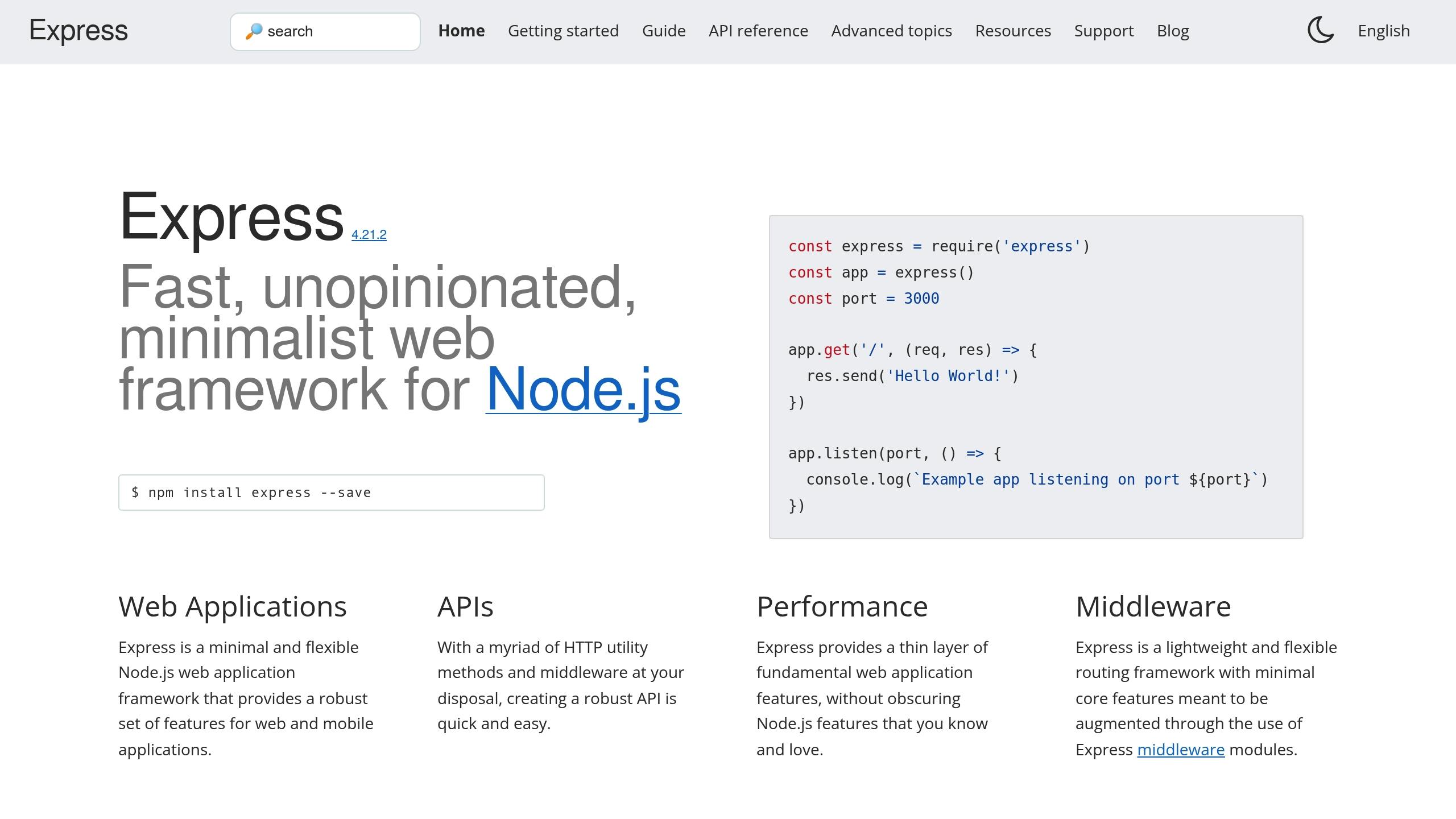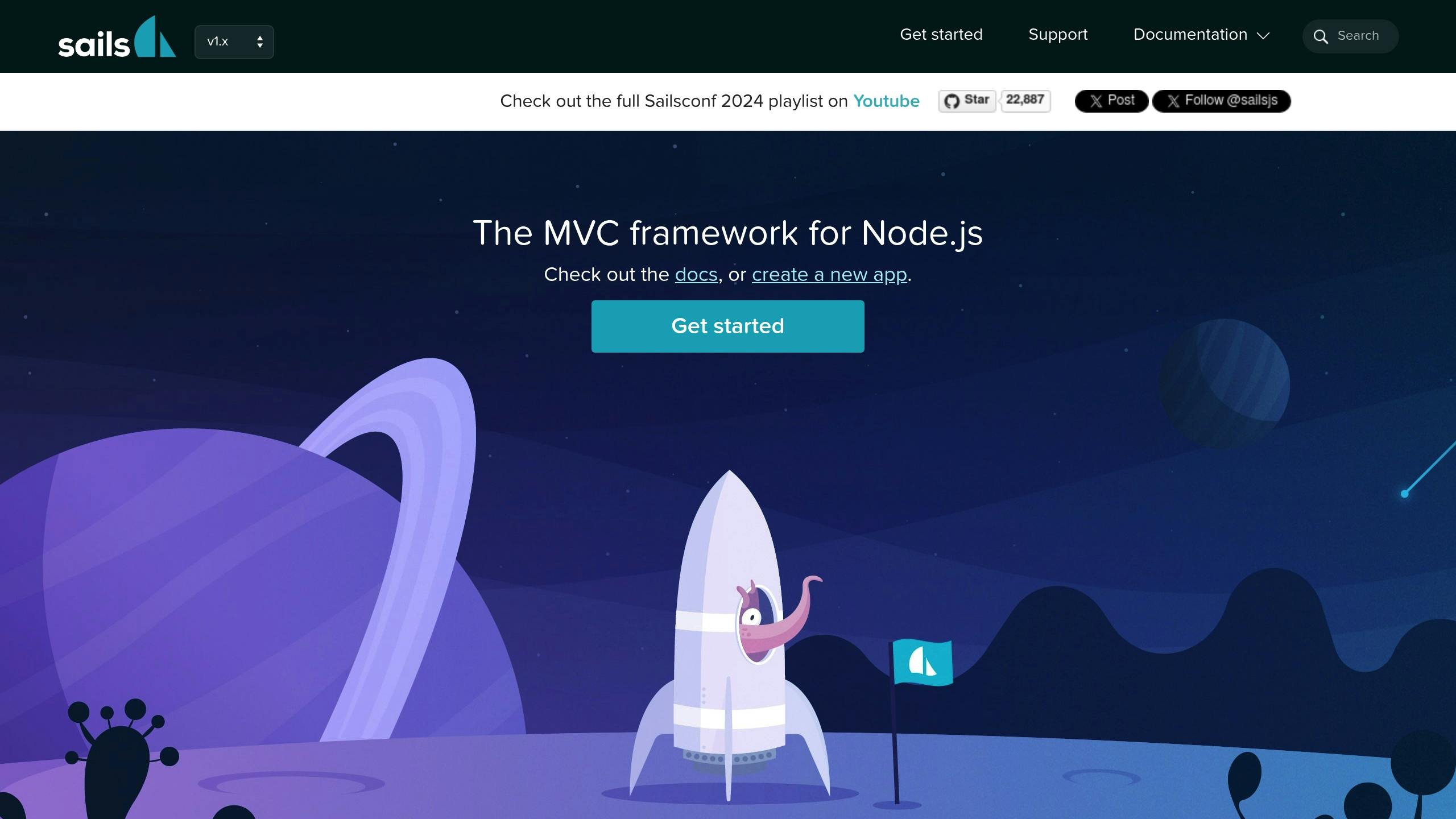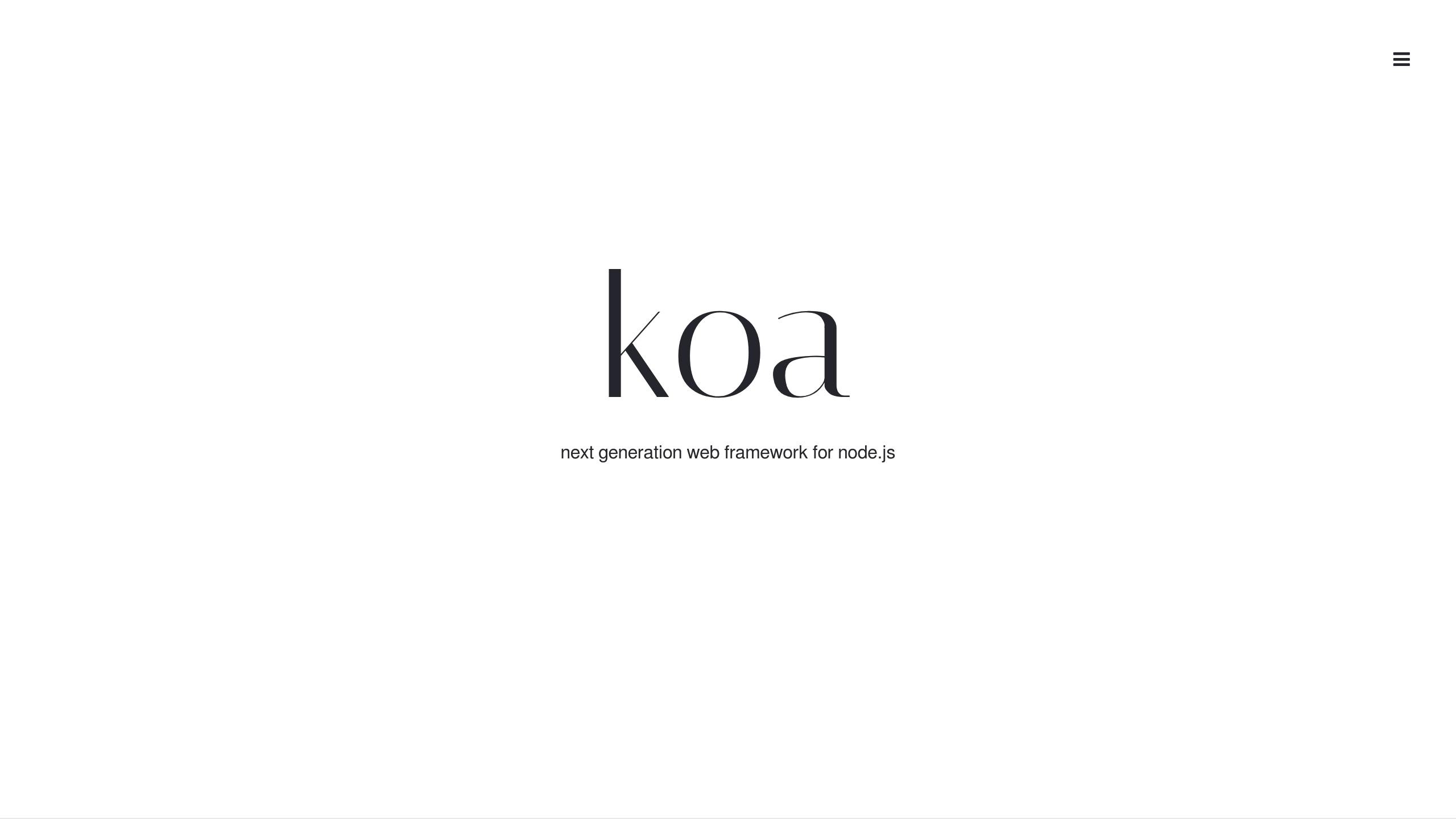Node.js frameworks power enterprise apps with scalability, performance, and reliability. Here are the top 5 frameworks for 2025, tailored to different business needs:
| Framework | Best For | Key Features |
|---|---|---|
| Express.js | Rapid API development | Flexible, middleware-rich, high performance |
| NestJS | Large-scale enterprise apps | TypeScript, modular architecture, dependency injection |
| Sails.js | Data-driven, real-time apps | MVC pattern, WebSocket integration, auto-generated APIs |
| LoopBack | API-first, microservices | Dynamic modeling, TypeScript, extensive database support |
| Koa.js | Modern web applications | Lightweight, async/await support, modular middleware |
Choose based on your project’s complexity, scalability needs, and team expertise. Each framework offers unique strengths for enterprise-grade applications.

Express.js is a popular framework for enterprise-level Node.js development. Its flexible design allows developers to build applications without being locked into specific patterns, making it ideal for large-scale integrations. Let’s break down how its features contribute to enterprise performance.
Express.js can handle up to 2,875 requests per second on Ubuntu virtual machines. Its single-threaded architecture ensures efficient request management without compromising reliability. Enterprises can further enhance performance with these strategies:
| Strategy | Implementation | Benefit |
|---|---|---|
| Compression | Gzip middleware | Smaller data transfers |
| Load Distribution | Integration with load balancers | Better request handling |
| Process Management | Cluster mode deployment | Optimized CPU usage |
| Caching | Reverse proxy setup | Faster response times |
These optimizations make Express.js a solid choice for handling enterprise-level traffic and workloads.
Express.js boasts a rich middleware ecosystem, enabling it to support critical enterprise functions. Companies have already leveraged its capabilities in various ways:
Express.js incorporates multiple layers of security to protect applications and data:
express-validator
express-rate-limithttpOnly flagsBy using JavaScript for both the frontend and backend, Express.js simplifies the development process. Its Model-View-Controller (MVC) structure ensures organized code, while its routing system efficiently handles high volumes of HTTP requests. This setup makes it easier for teams to work quickly and effectively.
Express.js's middleware system is one of its standout features. It allows developers to customize the request and response pipeline, integrate third-party packages, and maintain modularity. This flexibility ensures that Express.js can scale and adapt to meet the specific needs of enterprise applications.

NestJS brings a structured approach to enterprise Node.js development with its TypeScript foundation, ensuring more reliable and maintainable code. While Express.js offers flexibility in routing, NestJS stands out by addressing the needs of complex enterprise-level applications through its organized architecture.
NestJS focuses on improving performance and architecture with specific strategies:
| Strategy | Approach | Benefit |
|---|---|---|
| Provider Scope | Singleton providers | Lower memory usage and quicker dependency injection |
| Route Management | Selective middleware usage | Better request handling and reduced latency |
| Data Handling | Paginated queries | Efficiently manages large datasets |
| Response Optimization | Gzip/Brotli compression | Smaller payloads and faster delivery |
| CPU Utilization | PM2 cluster mode | Improved multi-core processing |
NestJS delivers essential tools and features tailored for enterprise applications:
The framework's modular and organized structure enhances development efficiency. As The Coding Insider highlights:
"NestJS stands out as the perfect framework for scalable enterprise applications due to its modular architecture, built-in features, TypeScript support, and ability to handle complex requirements."
To ensure top-tier performance in enterprise applications, developers should:
NestJS's abstraction layer also ensures seamless functionality across various platforms like HTTP, WebSockets, and microservices. performance-focused practices make NestJS a strong choice for handling enterprise demands effectively.

Sails.js offers a strong MVC framework paired with automation and detailed control, making it a solid choice for enterprise-level applications. Built on top of Express, it provides tools tailored to large-scale and complex systems.
Sails.js follows the Model-View-Controller (MVC) pattern, simplifying the development process. Here's a closer look at its architecture:
| Component | Features | Advantages |
|---|---|---|
| Model Layer | Waterline ORM Integration | Works with various databases |
| Controller Layer | Blueprint APIs | Speeds up API creation |
| View Layer | UI Agnostic | Works with any frontend framework |
| Security | Built-in Policies | Role-based access control |
| Real-time | Socket.io Integration | Supports WebSockets natively |
This structure ensures Sails.js can handle demanding applications while maintaining reliable performance under heavy loads.
Sails.js shines when it comes to handling large-scale applications. For example, Tourware Suite successfully built a scalable, stateless application using Sails.js by dividing tasks into separate processes:
By adopting a stateless design and using Redis for real-time notifications, the system scaled effortlessly across multiple servers. This setup supported millions of concurrent users. Tools like Throng further optimized performance by managing multiple processes efficiently.
Sails.js simplifies working with data through its Waterline ORM, offering:
These features make it easier to manage complex data workflows while keeping everything streamlined.
Sails.js speeds up development compared to using plain Express.js, thanks to its standardized approach. Key features include:
This framework is particularly well-suited for building real-time tools like dashboards, analytics platforms, collaborative apps, and messaging systems, making it a go-to option for enterprise-grade projects.

LoopBack 4 is designed to meet the needs of enterprise-level API development. By following SOLID principles, it ensures code remains clear and maintainable, even for complex integrations. Its design allows teams to establish their own standards while maintaining a structured framework.
LoopBack 4 streamlines API development with a range of features:
| Feature | Capability | Benefit |
|---|---|---|
| Dynamic Modeling | Schema modeling through a CLI wizard | Speeds up API creation |
| Database Support | Integrates with MongoDB, Oracle, PostgreSQL, MySQL | Simplifies data management |
| API Connect Integration | Works with the @loopback/apiconnect module | Improves API oversight |
| TypeScript Foundation | Built-in type safety | Boosts code reliability |
| Extension System | Offers clear extension points | Enables customization |
These capabilities make it easier to build, manage, and scale APIs effectively.
On a mid-2015 MacBook Pro (2.5 GHz Intel Core i7, 16 GB), LoopBack 4 delivered strong performance:
These benchmarks highlight its ability to handle demanding workloads with responsive performance.
LoopBack 4 integrates smoothly with existing systems, ensuring efficient workflows. For example, it has been successfully used in healthcare settings, connecting clinical, prescribing, and dispensing systems for large healthcare networks.
LoopBack 4 supports a structured yet flexible workflow:
Its modular design makes it a great fit for microservices, efficiently handling HTTP requests and responses.
LoopBack 4 has demonstrated its value in healthcare technology, where reliable API management and integration are critical. Its ability to handle complex data processes while maintaining excellent performance makes it an ideal choice for enterprise applications requiring robust API solutions.

Koa.js, created by the team behind Express, offers a streamlined approach to middleware, focusing on performance and scalability for enterprise applications.
Koa.js features a middleware architecture designed to be smaller, more expressive, and efficient. With a core of just 600 lines of code, it ensures high performance and flexibility. Its unique bidirectional middleware cascade gives developers precise control over how requests and responses are handled, contributing to its strong performance metrics.
Koa.js delivers impressive results in enterprise scenarios. Here’s a snapshot of its performance:
| Metric | Performance |
|---|---|
| Real-world JWT + MySQL Operations | 9,900 requests/second |
| Memory Usage | Minimal (core only) |
| Node.js Compatibility | Requires v12 or higher |
| Weekly npm Downloads | Around 300,000 |
Koa.js provides modular features tailored to enterprise needs:
Koa.js simplifies complex workflows with its middleware system. For example, centralized error handling is straightforward:
app.use(async (ctx, next) => {
try {
await next();
} catch (error) {
ctx.status = error.status || 500;
ctx.body = { message: error.message };
}
});
This example highlights how Koa.js handles errors efficiently.
Koa.js is well-suited for high-demand enterprise applications, offering features like:
Koa.js enhances the developer experience with:
These features streamline development and improve productivity.
Developers can fine-tune Koa.js for enterprise projects by:
koa-compose to structure middleware efficiently
Compare frameworks across key factors below.
Frameworks are designed with different strengths in mind. Express.js stands out for its speed, thanks to its simple and efficient architecture. Koa.js delivers similar performance with its lightweight and modular core. NestJS, while requiring more time to learn, is ideal for complex enterprise applications due to its strong TypeScript integration and scalability features. Sails.js shines in real-time application scenarios, and Loopback focuses on scalability with its API-first design.
Security implementation varies across frameworks. Express.js and Koa.js rely on well-established middleware like helmet for HTTP headers and packages for rate-limiting. NestJS comes with built-in security tools, while Sails.js uses integrated policies to enforce secure practices. Loopback provides a secure base tailored for API development. Whether you prefer built-in solutions or the flexibility of third-party tools depends on your project’s needs.
Each framework offers distinct advantages for developers:
The developer experience is another area where these frameworks differ. Express.js benefits from extensive documentation, a large community, and a rich plugin ecosystem. NestJS offers detailed documentation and high-quality learning resources, making it increasingly popular for enterprise-level projects. Sails.js and Loopback provide solid resources tailored to industry needs. Meanwhile, Koa.js, though more minimalistic, is backed by a dedicated community that values its maintainable, modular design.
While Express.js remains a flexible and reliable choice, NestJS is gaining traction for its structured approach and enterprise-ready features. Koa.js is an excellent pick for performance-focused projects, while Sails.js and Loopback cater to specific real-time and API-driven use cases effectively.
Pick a Node.js framework that aligns with your technical needs and business objectives. Community support is a key factor - Express.js has over 60,000 stars on GitHub, while NestJS boasts more than 55,000 stars. This level of backing ensures reliable updates and ample resources for developers. These metrics help narrow down the best framework for your project.
Here’s how to match frameworks to specific project requirements:
| Project Requirements | Recommended Framework | Key Benefits |
|---|---|---|
| Small to Medium APIs | Express.js or Koa.js | Quick setup, lightweight, flexible |
| Large Enterprise Systems | NestJS or Sails.js | Organized structure, TypeScript support |
| Real-time Applications | Sails.js or Socket.IO | WebSocket integration, real-time tools |
| High-Performance Apps | Fastify | Exceptional speed, minimal overhead |
| API-First Development | Loopback | Powerful data modeling, API automation |
While benchmarks highlight Koa.js for its high throughput, selecting a framework should go beyond performance stats.
"Choosing the right framework is like choosing the right tool for a job – it can make all the difference." - John Doe
Consider these additional factors to ensure the framework fits your enterprise needs:
To optimize performance, use middleware efficiently, reduce database queries, and implement caching strategically. Currently, Node.js powers about 3.9% of websites globally. Your framework choice will not only impact app performance but also influence development speed and long-term efficiency.